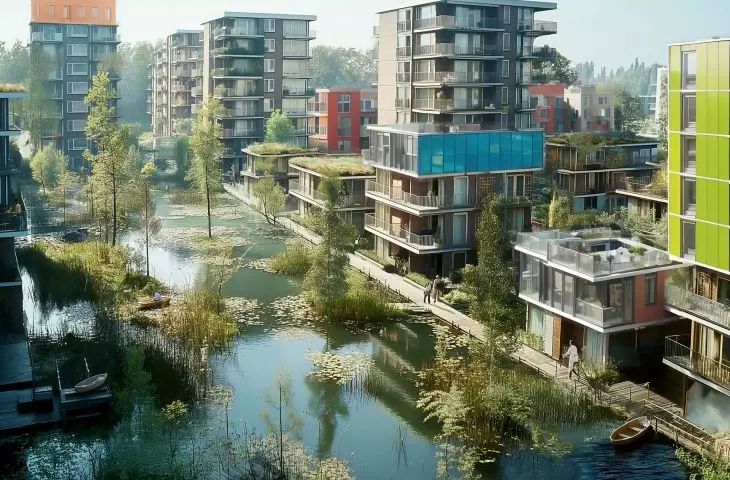MVRDV, IMOSS, Feddes/Olthof
"WHAT-IF: Nederland 2100".
[material prepared from the author's description of the studio].
The Netherlands has always been a country of wet lands—much of the land in the country today is formerly marshy wetlands or sea floor. Thanks to the development of agricultural technology over the centuries, this inhospitable environment has become one of Europe's most densely populated countries, one of the world's largest economies and the world's second-largest agricultural exporter—second only to the United States, a country with more than 200 times the area. But what happens when the Dutch status quo collides with global climate warming or demographic change? Will the 21st century mark the end of the Netherlands? These questions are pondered by MVRDV together with IMOSS and Feddes/Olthof studies in its latest publication WHAT IF: NL 2100.
This is what a hyper-dense city in the east of the Netherlands could look like
© MVRDV
A watery world—MVRDV scenario
In a research study, the architects leaned into the problems the country is likely to face in the coming century. In their work, they share visions showing how the Netherlands can learn to live in harmony with its changing environment while providing housing and a high quality of life, protecting its cultural heritage and adapting its economy to the new reality. The publication, published by Platform Ontwerp NL in cooperation with the Dutch Ministry of the Interior's Programa Mooi Nederland ("Programma Mooi Nederland"), aims to identify the steps needed to achieve this future.
Possible agricultural ienergetic solutions for a resurgent Netherlands
© MVRDV
clashing with the realities of the 21st century
The project is not just an academic exercise: in the face of a new far-right Dutch government that may introduce changes in urban planning policy, "WHAT-IF: Nederland 2100" provides important arguments in the social debate. In the long run, it could be a contribution to changing the direction of policy decisions that carry serious consequences. The study may also be useful globally—900 million people live in low-lying coastal areas threatened by climate change.
Vertical agriculture
© MVRDV
The {tag:Laboratory} has developed a decision matrix, a kind of "mixing board" of future scenarios. It introduces sliding scales for various aspects of urban planning, from the distribution of housing, green space, agriculture, industry, infrastructure, to the severity of global warming and population growth to how to deal with sea level rise (from highly technological to more natural approaches). The matrix also takes into account variations in the political climate. It serves to define coherent scenarios for the future, thus offering a narrowed explanation for each proposed vision.
Landscape of the future Netherlands
© MVRDV
WHAT IF: a black scenario for the Netherlands
All three studies decided to explore an extreme scenario: maximum projected global warming and maximum projected population growth.Such circumstances would likely force changes in the approach to managing water bodies, so the assumption was made that Dutch society would stop fighting the rising sea. Instead of shaping the landscape to suit human needs, as is the case now, human life would adapt to the natural landscape. Extreme sea level rise would mean that the low-lying western parts of the Netherlands, where the largest cities (including Amsterdam) and most of the population are located, would no longer be protected from the sea. The country would inevitably split into "sunken cities" in the west and higher, drier "sand cities" in the east.
Imagined geography by Dutch iurban architects
© MVRDV
In the MVRDV matrix
Using a decision matrix, MVRDV has developed a typology of cities according to this hydrological distinction. Sand cities in the east will become hyper-dense and make the most of their land. It will reorient the largest concentrations of the economy to the east, and thus the growing population. Agriculture will be transformed from horizontal fields to vertical farms, green belts around the cities will provide buffer zones for rainwater harvesting and production of bio-based materials, and residents will have access to planting areas on top of every building.
Amsterdam—a vertical city
Meanwhile, flooded cities in the West will take a completely different path, marked by floods that will force a new reality. In an effort to preserve historic Dutch architecture, historic city centers such as Amsterdam will be surrounded by floodwalls. However, architects realize that they won't save everything this way. Districts developed in the post-war period will be adapted to harmonize with the sea. First floors will be emptied, and roof top buildings will compensate for lost living space. The buildings will be connected by a network of footbridges at the "ground level". The dominant land use will become the production of materials on the biological base next to extensive areas ofdelta. Moving by boat and other forms of small water transport will become the norm.Not all solutions will be small-scale, as a hyper-modern intercity transport network will be built into the defense embankments.
The path of opportunity led namatrycy
© MVRDV
We explored ideas of what is possible in this study,"—Says Winy Maas, one of the founders of MVRDV. "It may seem tot rudimentary to imagine, but we could live on flooded land. We could construct vertical agriculture and turn Enschede into the most populous city in the Netherlands. It's enough for us to want it. The only thing we can't do is continue the status quo. We are deliberately building unsustainably, irresistibly and inflexibly—in a country that is largely below sea level. What we need now is a complete change in the understanding of what seems normal and reasonable, and what seems foolish and unsustainable.
Housing, energy, economy and natural conditions inHolland in the year 2100
© MVRDV
Ania Kociucka
Illustrations provided courtesy of the MVRDV studio.












































